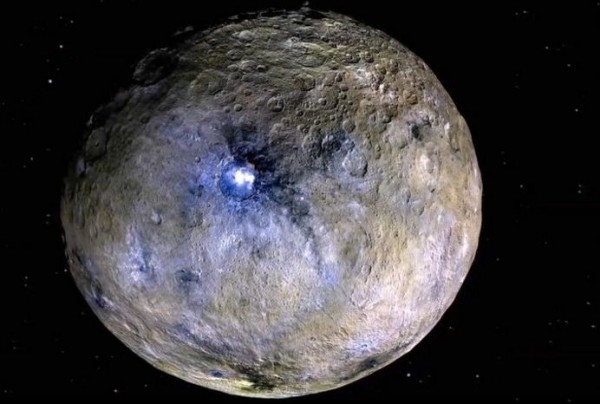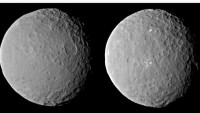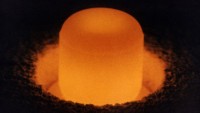Dawn to Continue Orbiting Ceres; NASA Rejects Option to Explore 145 Adeona
| Arthur Dominic Villasanta | | Jul 02, 2016 07:48 PM EDT |
(Photo : NASA JPL) Ceres
Members of the team at NASA's Jet Propulsion Laboratory overseeing the Dawn spacecraft orbiting the dwarf planet Ceres are dismayed by the agency's decision not to have Dawn explore the dark asteroid 145 Adeona.
NASA will instead support an extension for the New Horizons spacecraft mission now leaving Pluto to chase 2014 MU69, a massive and icy Kuiper Belt Object (KBO).
Like Us on Facebook
NASA bosses said Dawn will remain in orbit around Ceres, which it began orbiting on March 6, 2015, instead of visiting 145 Adeona in 2019. This 150 kilometer-wide asteroid in the main asteroid belt between Mars and Jupiter is a C-type asteroid probably composed of primitive carbonaceous material.
NASA planetary division director Jim Green said the agency's decision to forego 145 Adeona was based on recommendations of a senior review panel that evaluated all the agency's ongoing planetary missions,
"The long-term monitoring of Ceres, particularly as it gets closer to perihelion -- the part of its orbit with the shortest distance to the sun -- has the potential to provide more significant science discoveries than a flyby of Adeona," said Green.
NASA JPL mission leaders supported the trek to 145 Adeona since it would be better to exhaust Dawn's remaining fuel in exploring another large asteroid. There were dismayed by the decision to let Dawn continue orbiting Ceres.
Chris Russell, the Dawn mission's principal investigator at the University of California, Los Angeles, said the decision not to go to 145 Adeona was disappointing.
"We thought that everyone we had talked to about this plan was enthusiastic about it. I had no negative vibes until this particular moment."
Russell said it's a mistake to think the science of staying outweighs the chance to visit a new asteroid. He said Ceres has already been mapped and there are few signs of scientifically interesting changes in Ceres.
The Dawn mission was designed to study Ceres and Vesta, two large bodies in the asteroid belt, to answer questions about the formation of the Solar System. It was also to test the performance of its ion drive in deep space. Dawn is the first spacecraft powered by ion propulsion.
TagsDawn Spacecraft, Ceres, 145 Adeona, NASA, Jet Propulsion Laboratory
©2015 Chinatopix All rights reserved. Do not reproduce without permission
EDITOR'S PICKS
-

Did the Trump administration just announce plans for a trade war with ‘hostile’ China and Russia?
-

US Senate passes Taiwan travel bill slammed by China
-

As Yan Sihong’s family grieves, here are other Chinese students who went missing abroad. Some have never been found
-

Beijing blasts Western critics who ‘smear China’ with the term sharp power
-

China Envoy Seeks to Defuse Tensions With U.S. as a Trade War Brews
-

Singapore's Deputy PM Provides Bitcoin Vote of Confidence Amid China's Blanket Bans
-

China warns investors over risks in overseas virtual currency trading
-

Chinese government most trustworthy: survey
-

Kashima Antlers On Course For Back-To-Back Titles
MOST POPULAR
LATEST NEWS
Zhou Yongkang: China's Former Security Chief Sentenced to Life in Prison

China's former Chief of the Ministry of Public Security, Zhou Yongkang, has been given a life sentence after he was found guilty of abusing his office, bribery and deliberately ... Full Article
TRENDING STORY

China Pork Prices Expected to Stabilize As The Supplies Recover

Elephone P9000 Smartphone is now on Sale on Amazon India

There's a Big Chance Cliffhangers Won't Still Be Resolved When Grey's Anatomy Season 13 Returns

Supreme Court Ruled on Samsung vs Apple Dispute for Patent Infringement

Microsoft Surface Pro 5 Rumors and Release Date: What is the Latest?













